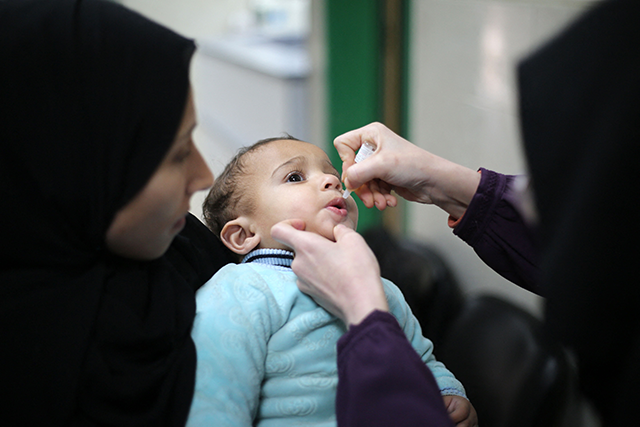GENEVA — The polio vaccination drive in Gaza is exceeding expectations, the WHO said Tuesday as it warned of the impacts of US funding cuts and pleaded for ramped-up medical evacuations.
Speaking from Gaza, Rik Peeperkorn, the World Health Organization's representative in the Palestinian territories, gave an update on a fresh polio child vaccination campaign, and an overview of the health and funding situation in the Gaza Strip.
Poliovirus, most often spread through sewage and contaminated water, is highly infectious and potentially fatal.
Since the disease resurfaced in Gaza for the first time in over 20 years, paralysing a 10-month-old child last August, two vaccination rounds took place in September and October 2024.
They reached more than 95 per cent of the children targeted with the necessary two doses of the oral vaccine.
But environmental samples from two sites, collected in December 2024 and January 2025, found poliovirus was still circulating.
A new polio vaccination campaign targeting 591,000 children under 10 began on Saturday. Nearly 548,000 have been reached so far, WHO said.
Despite cold and rainy conditions, parents brought their children to vaccination centres.
"That's a remarkable achievement, and personally I didn't think we would reach that," said Peeperkorn, citing high enthusiasm for the first two rounds.
A fourth round of vaccinations is planned in four weeks' time.
Medical evacuations
Between February 1 and 24, some 889 patients, including 335 children, were evacuated via the Rafah crossing into Egypt.
The total number of patients evacuated since October 2023 is 6,295, including 4,640 children.
The WHO estimates that 10,000 to 14,000 critical patients need medical evacuation, including more than 4,000 children.
Peeperkorn hoped medical evacuations to Jordan would begin soon, and pleaded for expanded medical corridors, including the pre-war traditional referral pathway to hospitals in the West Bank and East Jerusalem would resume, "otherwise we will be medevacing for years to come".
Money and US WHO pullout
The Gaza and West Bank Interim Rapid Damage and Needs Assessment, conducted earlier this month jointly by the United Nations, the World Bank and the European Union, estimated that $7 billion will be needed to repair the territory's devastated health system.
That amount was split between reconstruction costs and service delivery needs, with more than $4 billion needed in the first three years, it said.
The WHO's 2025 operational response plan for the Palestinian territories requires $648 million.
Peeperkorn also warned that the US pullout from the WHO meant the agency could no longer allocate some $46 million planned for use in Gaza, mostly this year.
This, he said, would leave particular areas underfunded, namely: procurement of supplies; enabling emergency medical teams; partner coordination including fuel; rehabilitation; medevac, and protection.
"It would have been so incredibly helpful in 2025. We could have used money for these areas," he said.
He said the WHO could go "full steam ahead" for now, as it still had $40-60 million in the pipeline, but warned that needed to stretch "for the whole of 2025, and then 2026 and beyond".
Peeperkorn said 18 of Gaza's 36 hospitals were partly functional, as were 59 of the 144 primary health care centres. Seven smaller field hospitals are also operational.
Gaza had more than 3,500 hospital beds before the war; that number went down to 1,110 and "now it's probably back to 1,500".
WHO hopes to get a pre-fabricated hospital into Gaza by March.
"Maybe there's not a need to rebuild all those 36 hospitals but focus on the ones which are absolutely needed, and make sure that you strengthen primary healthcare and the referral pathway," said Peeperkorn.
Peeperkorn insisted the health service and infrastructure in Gaza "has not collapsed", instead retaining partial or minimal functionality.
"I really credit that to the resilience of the Gaza health workers," he said.
Gaza had around 25,000 health workers before the war. Peeperkorn said many senior medical specialists had fled and he hoped a sustained ceasefire would see numbers return.
He said he had heard reports that 40 to 50 percent of the original health workers were still at their posts.
